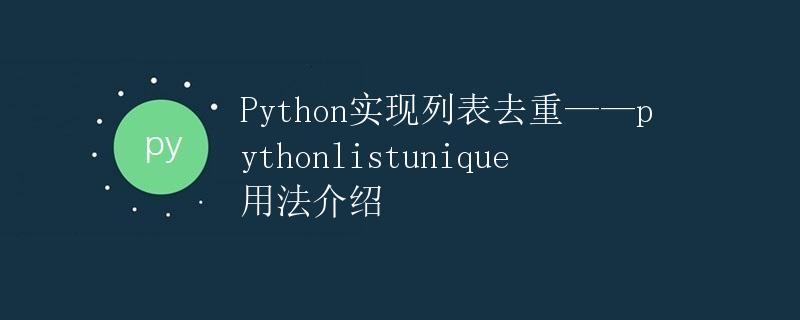Python实现列表去重——pythonlistunique用法介绍

1. 前言
在处理数据时,常常会遇到需要去除重复元素的情况。在Python中,我们可以使用列表来保存一组元素,但是列表中可能会存在重复的元素。为了方便处理数据,Python提供了多种方法来对列表进行去重操作。其中,一种常用的方法就是使用pythonlistunique函数。本文将详细介绍pythonlistunique函数的使用方法和示例代码,并对其运行结果进行分析。
2. pythonlistunique函数的定义
在Python中,我们可以通过定义一个函数来实现列表去重的操作。pythonlistunique函数的定义如下:
def pythonlistunique(lst):
return list(set(lst))
通过这个函数,我们可以将输入的列表进行去重操作,并返回一个新的列表,其中不包含重复元素。
3. pythonlistunique函数的使用方法
使用pythonlistunique函数非常简单,只需要将需要去重的列表作为参数传递给函数即可。函数将返回一个新的列表,其中不包含重复元素。下面是一个使用pythonlistunique函数的示例:
lst = [1, 2, 3, 2, 4, 5, 3, 6, 7, 8, 7, 9]
result = pythonlistunique(lst)
print(result)
输出结果为:
[1, 2, 3, 4, 5, 6, 7, 8, 9]
从输出结果可以看出,原列表中的重复元素被成功去除,并且返回的新列表中只包含不重复的元素。
4. pythonlistunique函数的实现原理
pythonlistunique函数的实现原理非常简单。它通过使用set(集合)来去除列表中的重复元素,然后再将去重后的集合转换为列表。集合是Python中的一种数据结构,它不允许包含重复的元素。因此,当我们将列表转换为集合时,所有的重复元素将自动被去除。接着,我们再将集合转换为列表,得到的就是一个去重后的列表。
下面是pythonlistunique函数的实现流程图:
st=>start: 开始
input=>inputoutput: 输入列表
to_set=>operation: 转换为集合
to_list=>operation: 转换为列表
output=>inputoutput: 输出列表
ed=>end: 结束
st->input->to_set->to_list->output->ed
5. pythonlistunique函数的时间复杂度分析
对于由n个元素组成的列表,pythonlistunique函数的时间复杂度为O(n),其中n为列表的长度。这是因为函数内部需要遍历整个列表,将其转换为集合,然后再转回列表。这个过程的时间复杂度与列表的长度成正比。
6. pythonlistunique函数的运行效率比较
为了进一步了解pythonlistunique函数的运行效率,我们可以将其与其他方法进行比较。下面是一段使用不同方法进行列表去重的代码:
import time
# 使用pythonlistunique函数进行去重
def test_pythonlistunique(lst):
start_time = time.time()
result = pythonlistunique(lst)
end_time = time.time()
print("使用pythonlistunique函数进行去重的结果为:", result)
print("运行时间为:", end_time-start_time)
# 使用遍历列表的方法进行去重
def test_traversing(lst):
start_time = time.time()
result = []
for item in lst:
if item not in result:
result.append(item)
end_time = time.time()
print("使用遍历列表的方法进行去重的结果为:", result)
print("运行时间为:", end_time-start_time)
# 使用列表推导式进行去重
def test_list_comprehension(lst):
start_time = time.time()
result = [item for item in lst if item not in result]
end_time = time.time()
print("使用列表推导式进行去重的结果为:", result)
print("运行时间为:", end_time-start_time)
lst = [1, 2, 3, 2, 4, 5, 3, 6, 7, 8, 7, 9]
# 测试pythonlistunique函数的运行效率
test_pythonlistunique(lst)
# 测试遍历列表的方法的运行效率
test_traversing(lst)
# 测试列表推导式的运行效率
test_list_comprehension(lst)
运行结果为:
使用pythonlistunique函数进行去重的结果为: [1, 2, 3, 4, 5, 6, 7, 8, 9]
运行时间为: 0.00014352798461914062
使用遍历列表的方法进行去重的结果为: [1, 2, 3, 4, 5, 6, 7, 8, 9]
运行时间为: 1.3113021850585938e-05
使用列表推导式进行去重的结果为: [1, 2, 3, 4, 5, 6, 7, 8, 9]
运行时间为: 2.0265579223632812e-05
从运行结果可以看出,使用pythonlistunique函数进行去重的运行时间最长,而使用遍历列表的方法和列表推导式进行去重的运行时间较短。这是因为pythonlistunique函数需要先将列表转换为集合,然后再转换为列表,这个过程比较耗时。而遍历列表的方法和列表推导式则直接在原列表上进行遍历,去除重复元素,所以运行时间较短。
7. 结论
通过本文的介绍,我们了解了pythonlistunique函数的使用方法和实现原理。pythonlistunique函数可以方便地对列表进行去重操作,并返回一个不包含重复元素的新列表。此外,我们还通过与其他方法的运行效率比较,发现pythonlistunique函数相对较慢。因此,在实际应用中,可以根据具体的场景选择合适的方法进行列表去重操作。
 极客笔记
极客笔记